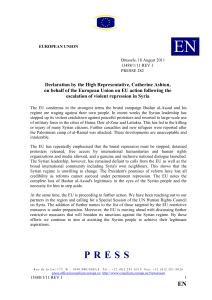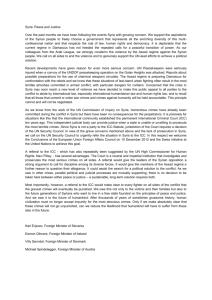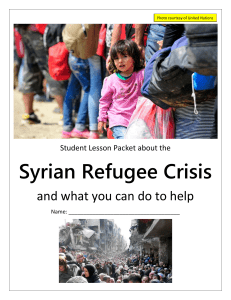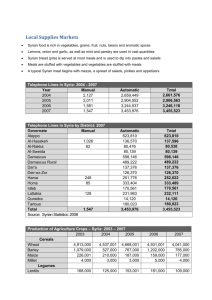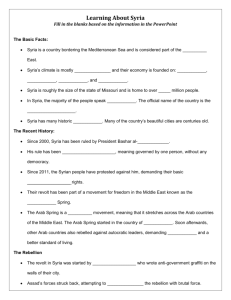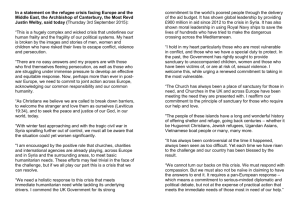Topic I: Situation in Syria - University of Victoria Model United
advertisement
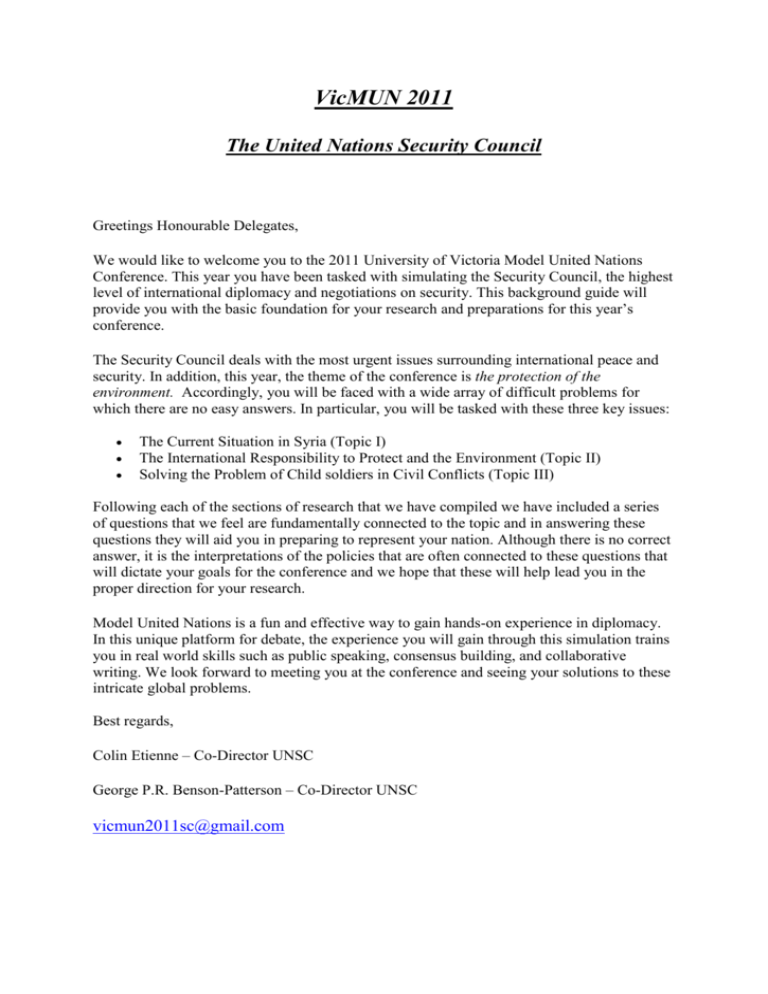
VicMUN 2011 The United Nations Security Council Greetings Honourable Delegates, We would like to welcome you to the 2011 University of Victoria Model United Nations Conference. This year you have been tasked with simulating the Security Council, the highest level of international diplomacy and negotiations on security. This background guide will provide you with the basic foundation for your research and preparations for this year’s conference. The Security Council deals with the most urgent issues surrounding international peace and security. In addition, this year, the theme of the conference is the protection of the environment. Accordingly, you will be faced with a wide array of difficult problems for which there are no easy answers. In particular, you will be tasked with these three key issues: The Current Situation in Syria (Topic I) The International Responsibility to Protect and the Environment (Topic II) Solving the Problem of Child soldiers in Civil Conflicts (Topic III) Following each of the sections of research that we have compiled we have included a series of questions that we feel are fundamentally connected to the topic and in answering these questions they will aid you in preparing to represent your nation. Although there is no correct answer, it is the interpretations of the policies that are often connected to these questions that will dictate your goals for the conference and we hope that these will help lead you in the proper direction for your research. Model United Nations is a fun and effective way to gain hands-on experience in diplomacy. In this unique platform for debate, the experience you will gain through this simulation trains you in real world skills such as public speaking, consensus building, and collaborative writing. We look forward to meeting you at the conference and seeing your solutions to these intricate global problems. Best regards, Colin Etienne – Co-Director UNSC George P.R. Benson-Patterson – Co-Director UNSC vicmun2011sc@gmail.com History and Structure of the Security Council Following the formation of the United Nations on October 24 1945 the Security Council held its first meeting on January 17 1946 in London. The council originally consisted of eleven member nations, five permanent member and 6 non-permanent members who served on two year terms.1 Following an amendment to the UN Charter in 1965, the total number of seats on the Security Council was increased to 15 by increasing the non-permanent membership to ten seats. From the origins of the Security Council, the five permanent members (the P5) have remained fundamentally the same, although officially, two of the seats have changed.Following the stalemate in Chinese Civil War the original Security Council seat was given to the Republic of China (Taiwan); however in 1971 the People’s Republic of China took over the seat. The other seat to change came in 1991 with the collapse of the Soviet Union. When the USSR broke apart the Russian Federation succeeded the seat officially in 1991. The permanent members of the Security Council are: The French Republic, the United Kingdom of Great Britain and Northern Ireland, the People’s Republic of China, the Russian Federation, and the United States of America, Along with the five permanent members of the Security Council, 10 non-permanent members are elected by the UN General Assembly to serve for two year terms.2 Currently, the elected members are: Bosnia and Herzegovina, the Federative Republic of Brazil, the Republic of Columbia, the Gabonese Republic, the Federal Republic of Germany, the Republic India, the Republic of Lebanon, the Federal Republic of Nigeria, the Republic of Portugal and the Republic of South Africa. The presidency of the Security Council rotates monthly based on alphabetical order. The President of the Security Council at the time of VICMUN will be Nigeria, although the roles of the President will have already been fulfilled by the secretariat. The Security Council has slightly modified rules of procedure compared to the other bodies at the United Nations. The rules of procedure that we will follow are outlined in the delegate package for VICMUN with a few amendments. The largest amendment to the rules of procedure is the rule of Great Power unanimity, or ``veto``. What this rule requires is that all of the five permanent members are either affirmative or abstain when voting on substantive matters in order to pass any resolution.3 All member nations are obliged to carry out the resolutions of the Security Council as a part of the Charter of the United Nations, meaning that all resolutions are binding. To accommodate this, delegates representing pertinent nations to a resolution can be brought to a session of the Security Council at the discretion of the secretariat to answer questions or provide the input of their state.4 The Security Council is also the only UN body that has the authority to create a military force in the form of United Nations Peacekeeping missions or in response to aggression, as was done at the outbreak of the Korean War on June 27, 1950 under resolution 83.5 “United Nations Security Council”. http://www.britannica.com/EBchecked/topic/532070/United-NationsSecurity-Council . Accessed August 3 2011. 2 “UN Security Council: Members” http://www.un.org/sc/members.asp . Accessed August 10, 2011. 3 ``UN Security Council: Members`` http://www.un.org/sc/members.asp . Accessed August 10, 2011. 4 Note: Delegates will not be pulled from a formal session, voting procedure or against their will. All requests must be submitted in writing to the dais. 5 ``UNSC Resolution 83``. http://daccess-ddsny.un.org/doc/RESOLUTION/GEN/NR0/064/96/IMG/NR006496.pdf?OpenElement . Accessed August 10, 2011 1 Conflict Resolution The direct purpose of the Security Council is to resolve conflicts by peaceful means: through direct diplomacy, mediation, economic sanctions and restrictions, and in cases of acts of aggression or to prevent internal conflict and genocide – military intervention. The Security Council has a mixed rate of success when it comes to conflict resolution and prevention. Since its inception, the Security Council has served to organize the response to North Korean aggression in the 1950`s, provide peacekeeping support to civil conflicts such as the breakup of Yugoslavia, pursue crimes against humanity in Bosnia and Herzegovina, and brought cases before the International Criminal Court as in Darfur and Libya. Yet, the Security Council has proven ineffective in a number of cases. This was seen when efforts to stop the crimes against humanity in the Sudan and in turn the Sudanese government was blocked by permanent members over resources in the Sudan, or in Rwanda when the UN Peacekeeping force was unable to respond to the genocide unfolding in front of them, or in Bosnia when Bosnian`s were massacred in a UN safe zone6. These failures have caused very harsh criticism directed towards the Security Council for creating ineffective responses to some of the direst of situations. This is the most significant task facing the Security Council, what response can the Security Council authorize without exacerbating the initial problem while still resolving the conflict that is brought before them. Questions to Think About: What is my country`s history on the Security Council? If a non-permanent member: Have I been elected before and what were our goals then? If permanent: What is my country’s philosophy on the veto? What international work is my country currently focused on? Topic I: Situation in Syria "Seek not mischief in the land, God does not love mischief makers." - Qur'an, 28:77. Introduction With the ongoing violence and political upheavals in the Middle East, it should be of no surprise that Syria, long one of the bastions of political repression in the region, is also under fire. Bashar al-Assad, son of Syria’s previous president who had taken power in a bloodless coup in 1970, has been attempting to maintain his control over power despite facing near continuous protests since January, when a general wave of unrest swept across the entire Middle East. Having toppled such mainstays of political stability in the region as Tunisia and Egypt, al-Assad’s measures to contain the unrest have reached a boiling point. At first oscillating between hints of reform and repression, al-Assad, even after lifting the forty yearold state of emergency began to crack down on those who had spoken out against the 6 ``Genocide in the 20th Century``. http://www.historyplace.com/worldhistory/genocide/bosnia.htm . Accessed August 10, 2011. government. After more protests broke out in May, following the release of a video onto the Internet which showed the torture and death of a young Syrian boy at the hands of al-Assad’s forces, the beleaguered President decided to send troops to the heart of the anti-government protests, the town of Jisr al-Shughour. Despite a massive advantage in resources, an entrenched security system, and an infrastructure of fear, President al-Assad has been unable to quell the resistors. The growing level of violence and number of deaths means that the international community has taken notice of the situation, and demanded action is considering intervention. History The nation that would become Syria has a long and illustrious history, being the centrepiece at one point or another, of human civilisation. While long part of an independent pan-Asiatic, and later pan-Islamic empire, the period of Muslim rule ended with the collapse of the Ottoman Empire after World War I. It was administered under France as a mandate under the League of Nations until their fall to the Germans in World War II. Syria declared independence in 1941, though it was not until 1946 that French troops left the country. A brief period of republican rule followed, only to end in 1949 with a military coup d'état. Wars with Israel followed, first in 1948, then in 1967, 1973, and very nearly in 1957. Tensions in the region were particularly acute in the region in the 1950’s and 1960’s, with multiple coups and border skirmishes, particularly with Jordan and Turkey, during this time. Syria briefly became a part of a federation with Egypt in 1958, but this ended three short years later in 1961. In 1963, a group of leftist civilian and military leaders took over the provisional ruling council of the country. Shortly after, the Ba’athist party and its followers came to control the ruling council . This control was solidified with the takeover by Defence Minister Hafez alAssad on November 30 , 1970. Al-Assad quickly centralised the Syrian bureaucratic system and installed a formidable and stable social infrastructure that kept his regime in power for the remainder of his natural life. Despite multiple wars with Israel during his reign, a thirtyyear military adventure in Lebanon, and multiple rises in tensions between Syria, its neighbours, and the international community at large, al-Assad’s regime proved remarkably resilient. The regime survived a number of political uprisings, both from within the own power structure and outside of it. The main opposition came from the Muslim Brotherhood, an organisation opposedto the secular, socialist ideology that the Ba’athists subscribed to. th The closing of the 20 Century marked the closing of Hafez al-Assad’s rule, too. He died on June 10 , 2000, and was succeeded by his son, Bashar. The transition of power after some thirty years was quite a political event in the country, and even many outside of Syria and the region looked at the event as a hopeful sign that Syria would soon open up. This was not to be the case. While initially using a rhetoric that suggested that a transition to democracy would be in the near future, Bashar al-Assad’s rule was marked by a style very similar to his father’s own repressive authoritarianism. The “Damascus Spring” of 2001, in which many Syrian intellectuals and ex-patriots spoke of political reform began with Bashar’s assent, and the release of a number of political prisoners.7 But despite his early hope, this spring was not to last, and Bashar quickly cracked down on dissenters. Ethnic tensions increased under his watch, as the Kurds in Syria grew increasingly agitated with al-Assad’s measures against th th 7 BBC News, “Syria Country Profile.” BBC News. July 13 , 2011. <http://news.bbc.co.uk/2/hi/middle_east/country_profiles/801669.stm> th them.8 While economically opened since the death of his father, al-Assad’s critics maintained that he upheld a political system equally as repressive as that of his father, while the country became equally restless beneath the surface. The Present Situation Following the toppling of the regime of President Ben Ali in Tunisia, and later Hosini Mubarak of Egypt, Bashar al-Assad’s own regime came under sharp domestic criticism. Buoyed by the successful revolutions in these two countries and the growing resistance to Colonel Muammar al-Gaddafi in Libya, protests became increasingly vocal against the sitting President. By mid-March, they had grown large enough to attract the interest of both alAssad’s security forces, as well as the international community. Government security forces opened fire on protestors who had been spray-painting anti-Bashar slogans around the small town of Deraa, and the instability quickly spread.9 The government made several attempts to stifle the protests, but the protests quickly grew to a size that made a quiet conclusion difficult. Throughout the entirety of March, al-Assad attempted to calm the protestors by releasing a number of political prisoners, and promising reform, including creating an exploratory committee that would considering ending the fortyeight year-old state of emergency that was in place since the al-Assad family first took power. Al-Assad kept his word, and by April 21 , state of emergency that had been in place for over forty years came to an end, but the protestors were not satisfied. They planned a “Great Friday” protest, which tens of thousands of Syrians showed up for, hoping to register their dissatisfaction with the government. That same day, however, security forces arrived to break up the crowds, and news agency al Jazeera reported thatthey had used live ammunition on the crowds.10 st The current situation is tenuous. The United States and the European Union have placed sanctions on al-Assad and his inner circle, hoping to pressure them into reforming the country, but these actions appear ceremonial more than anything. In reality, neither has any real leverage over the regime, and they are not entirely sure they would like to see the regime entirely dismantled. A rapid disintegration of Syria could wreak havoc on all of the nearby countries, as the strong-man position that Bashar al-Assad sits in has enabled him to hold together a highly diverse country. If he and his government were to fall, it is possible that Syria could devolve into a situation similar to Iraq in 2008.11 Whatever action it decides to take, the United Nations Security Council will have to be mindful of these facts as it balances the twin priorities of protecting innocent Syrian civilians and the peace and stability of the entire region. 8 Human Rights Watch, “Syria: Address Human Rights Grievances Underlying Kurdish Unrest.” Human Rights Watch. March 18th, 2004. <http://www.hrw.org/en/news/2004/03/18/syria-address-grievances-underlyingkurdish-unrest> 9 BBC News “Q&A: Syrian Protests.” BBC News, June 21, 2011. <http://www.bbc.co.uk/news/world-middle-east-13374395> 10 Al Jazeera “Timeline: Unrest in Syria.” Al Jazeera News, July 1 , 2011. <http://english.aljazeera.net/news/middleeast/2011/03/2011329155923973612.html> 11 BBC News “Q&A: Syrian Protests.” BBC News, June 21, 2011. <http://www.bbc.co.uk/news/world-middle-east-13374395> st Role of the United Nations Security Council Because of the contentious history of Syria within the United Nations Security Council, it should come as no surprise that a resolution has yet to be passed regarding the situation. Russia in particular has made sure to register its worry that the situation in Syria will turn into another Libya.12The Russian, Chinese, Indian, and South African delegations to the Security Council have made clear that they will not support another armed incursion into a state in a delicate situation, particularly in the Middle East. As of August 3rd, 2011, in light of the growing violence in Syria, the Security Council passed a Presidential Statement, read by Indian representative Hardeep Singh Puri, which spelled out the UNSC’s position on the situation. The Security Council expressed “grave concern at the deteriorating situation in Syria,” and called upon the Syrian government to both restrain itself from violence and human rights abuses, as well as to honour its announced commitments to reform.13 In response to this, the Syrian government has continued its actions against the protestors. This does not mean that action has not been taken against Syria, however. The United States and the European Union have passed legislation that specifically punishes the President alAssad and his inner circle. In a statement released on March 22nd, the EU has made clear it “strongly condemns the violent repression, including through the use of live ammunition, of peaceful protests in various locations across Syria.” 14 The United States and Europe in particular have taken a hard line and frozen all of the assets that Mr al-Assad has in their countries, though as of yet it has had little to no visible effect on the decision-making process of the Syrian authorities.15 Points of Discussion Syria’s situation is clearly tenuous, but by no means is this the full-blown civil war that Libya was already devolving into by the time the Security Council got involved. The government clearly maintains the upper-hand, despite whatever may be true about the rumours of desertions amongst the troops. Most of the troops are of the minority Alehwahi sect of Islam (as opposed to Syria’s Sunni majority), and therefore have little reason to desert their leader in his hour of need, because they already gain so much from his rule.16 The pressing question remains: just how far will the violence go, and at what point does the Security Council have a right to step in. The draft resolution submitted by the United Kingdom and France in its second, edited version, suggested an independent tribunal be established to look for Crimes against Humanity that may have been committed during the unrest. Russia in particular voiced a Voice of Russia. “Russia, China Block 2nd Draft Resolution on Syria.” Voice of Russia, June 11th, 2011 < http://english.ruvr.ru/2011/06/10/51517343.html> 13 “Security Council, in statement, Condemns Syrian Authorities for ‘widespread violations of human rights, use of force against Civilians.’” United Nations Security Council, August 3rd, 2011. <http://www.un.org/News/Press/docs/2011/sc10352.doc.htm> 14 Middle East Online. “EU Condemns Unacceptable Repression in Syria.” Middle East Online. March 22nd, 2011. <http://www.middle-east-online.com/english/?id=45066> 15 “US Freezes Assets of Syrian Officials.” Wall Street Journal, April 30th, 2011 <http://online.wsj.com/article/SB10001424052748704473104576293454097653620.html> 16 BBC News “Q&A: Syrian Protests.” BBC News, June 21, 2011. <http://www.bbc.co.uk/news/world-middle-east-13374395> 12 concern that the protesters – it is unclear whether or not they can be called rebels at this point – might take this as tacit support from the Security Council and use it as fodder with which to continue to fight the al-Assad regime, rather than engage in dialogue. 17Secretary General Ban-Ki Moon has already suggested that the violence being used by President al-Assad is “totally unacceptable,” but given the regime’s tendency to chart a course sometimes deliberately opposed to what the international community expects, or even demands, it remains unknown if the regime would be able to have the sort of discussion about reforms that the protesters and many Western governments want, or even if it could be defeated with force. If all internationally-backed negotiations fail, the fallout from any aggressive military campaign in Syria, domestic or internationally supported, could be extreme, to say the least. Starting Points for Research When considering the information already laid out, here are some further points on which to direct the research that will help you formulate your position paper: What is the relationship that your country had to Syria previous to these protests? What role in the wave of protests, known colloquially as the “Arab Spring”, has your country had? In previous scenes of international intervention, what role has your country played? How has your country reacted to the situation in Libya – did it vote for the no-fly zone? Is your country a developing one? What has the informal caucus (particularly the BRICS nations) of developing countries had to say on this issue? Topic II: Responsibility to Protect and Environmental Degradation "The ultimate test of man's conscience may be his willingness to sacrifice something today for future generations whose words of thanks will not be heard." - Gaylord Nelson Introduction The Intergovernmental Panel on Climate Change has made clear that action on the issue of environmental degradation is essential to the continued health and development of mankind on earth – failure to act could result in dire consequences not only for the planet , but for human life as well. With the realisation that climate change demands immediate and concerted action, a variety of responses have been initiated, with varying degrees of success. Initiatives such as the Intergovernmental Panel on Climate Change, the Global Climate Change Fund, and others have been moving forward to address some of the causes of climate change in an effort to stave off disastrous circumstances - but the reality is that they will not always be successful. There will come a time, and some say it is already here, where humanity will pay the cost of profligate use of natural resources, unbridled pollution and other crimes against the planet. To that end, it is clear that rapid responses will be needed, where international agreements such as the Kyto Protocol will be totally unhelpful. In 2009, the General Assembly discussed broadening the criteria for the use of the Responsibility to Protect, which currently exists only BBC News “Syria Crisis: Draft Resolution Submitted by UK and France.” BBC News. June 9th, 2011 <http://www.bbc.co.uk/news/world-middle-east-13706317> 17 in the context of war crimes, crimes against humanity, genocide, and ethnic cleansing. In some states and peoples’ eyes, this was an unfortunate turn of events, but now this topic will once again have the opportunity to be considered, and the necessary changes made - if agreed upon. History In the wake of the Rwandan genocide, one of the worst humanitarian disasters in recent memory, the international community considered a new framework to help prevent future disasters. The International Commission on Intervention and State Sovereignty was convened by the government of Canada in 2000 to consider these questions. The ICISS completed its report, The Responsibility to Protect, and released it in 2001. Since that time, the concept of the responsibility to protect, has been elaborated on and mentioned repeatedly in international discourse. The doctrine of the responsibility to protect is best represented in the 2005 World Summit Document where it states that: Each individual State has the responsibility to protect its populations from genocide, war crimes, ethnic cleansing and crimes against humanity. This responsibility entails the prevention of such crimes, including their incitement, through appropriate and necessary means. We accept that responsibility and will act in accordance with it. The international community should, as appropriate, encourage and help States to exercise this responsibility and support the United Nations in establishing an early warning capability. And furthermore that: The international community, through the United Nations, also has the responsibility to use appropriate diplomatic, humanitarian and other peaceful means, in accordance with Chapters VI and VIII of the Charter, to help protect populations from genocide, war crimes, ethnic cleansing and crimes against humanity. In this context, we are prepared to take collective action, in a timely and decisive manner, through the Security Council, in accordance with the Charter, including Chapter VII, on a case-by-case basis and in cooperation with relevant regional organizations as appropriate, should peaceful means be inadequate and national authorities manifestly fail to protect their populations from genocide, war crimes, ethnic cleansing and crimes against humanity. We stress the need for the General Assembly to continue consideration of the responsibility to protect populations from genocide, war crimes, ethnic cleansing and crimes against humanity and its implications, bearing in mind the principles of the Charter and international law. We also intend to commit ourselves, as necessary and appropriate, to helping States build capacity to protect their populations from genocide, war crimes, ethnic cleansing and crimes against humanity and to assisting those which are under stress before crises and conflicts break out.18 18 “World Summit Outcome Document.” United Nations. September 15th, 2005. <http://www.who.int/hiv/universalaccess2010/worldsummit.pdf> The doctrine lays the theoretical groundwork for intervention in the domestic affairs of states, should they be unable to protect their population rom the dangers of ethnic cleansing, war crimes, genocide, and crimes against humanity. But the question has remained, despite the very clearly outlined programme of the responsibility to protect, what other areas might warrant intervention? In 2009, the General Assembly had a debate on the responsibility to protect, which garnered widespread participation and a plethora of new ideas. Some of these ideas included the possibility of expanding the criteria for intervention to include pandemics, natural disasters, HIV/AIDS, and even climate change. The debate was drawn-out, but the eventual decision was that no new criteria would be added. The Secretary General offered that the inclusion of too many new principles could “undermine the 2005 consensus and stretch the concept beyond recognition or operational utility.”19 But, the question of what to do to combat rising levels of environmental degradation, increasingly volatile climate systems, and their effects on world food supplies, economic growth, and overall global political stability, remains. Role of the Security Council The role of the Security Council will be to provide advice to both the Secretary General and the General Assembly on the ideological underpinning of the doctrine of the responsibility to protect. They cannot change the doctrine as a legal concept, per se, but their recommendations do heavily influence the decisions of the General Assembly. Points of Discussion The original debate over the Responsibility to Protect was primarily focused on whether or not it would be permissible for states to intervene in situations of violence and civil strife, this new discussion centres on whether or not it would dilute or confuse the original purpose if more situations where intervention might be suitable. For the purposes of this special session of the Security Council, which is being held under the auspices of a United Nations conference on the environment, the particular topic of discussion will be whether or not the Security Council should make a recommendation to the General Assembly to include environmental degradation as a cause for the invocation of the responsibility to protect. Previous criticisms against widening the criteria for intervention have all centred around the sheer number of possibilities that exist for such a widening. If all such possibilities were included, such as pandemics, natural disasters, and climate change related abuses, then the responsibility to protect could be so diluted as to become unstable. However, many environmental activists feel that there are numerous unresolved, “crimes against the planet”, that can and should be tackled under the banner of the responsibility to protect. The fact that the responsibility carries such a powerful legal weight in the international system, both legal and otherwise, could mean that numerous instances of environmental abuse could be more 19 Remarks by H.E. Ambassador Maria Luiza Ribeiro Viotti, Permanent Representative of Brazil to the United Nations” Brazilian Mission to the United Nations. July 23, 2009 <http://www.responsibilitytoprotect.org/Brazil_ENG.pdf> readily tackled, and those responsible, held accountable. Instances such as the breakdown of the Deepwater Horizon oil-drilling platform in the Gulf of Mexico, or the instances of environmental degradation in Ecuador due to resource exploration by Chevron could be possible instances for international intervention, based on the responsibility to protect, and would certainly instil further impetus for nations to control their domestic ecological welfare. Delegates will have to decide whether the possibility of preventing potentially catastrophic ecological degradation, which could well lead to untold human suffering is outweighed by the need to ensure that humanitarian intervention occurs only in matters where human lives are directly threatened, such as in situations of genocide or ethnic cleansing. Striking a balance between these two has proven difficult in the past, and it will be up to this Security Council to decide where the emphasis should fall. Starting Points for Research When considering the information already laid out, here are some further points on which to direct the research that will help you formulate your position paper: What role did your country play in formulating the original responsibility to protect? Did you participate in the 2009 General Assembly Debate on the Responsibility to Protect? What history of humanitarian intervention does your country have? Does your country have a strong environmental rights movement? Is your country developing, or developed? Does your country have experience with wide-spread environmental disaster, a la the Deepwater Horizon spill, the Fukishima reactor leak, or other such catastrophes? Topic III: Solving the Problem of Child Soldiers in Conflict “Compelled to become instruments of war, to kill and be killed, child soldiers are forced to give violent expression to the hatreds of adults” - Olara Otunnu Introduction When looking at the modern setting for conflicts, largely in the developing world, there has become a very prominent factor in these conflicts: the exploitation and implementation of child soldiers. Under the Paris Principles of 2007 a child soldier is defined as: Any person below 18 years of age who is or who has been recruited or used by an armed force or armed group in any capacity, including but not limited to children, boys, and girls used as fighters, cooks, porters, messengers, spies or for sexual purposes. It does not only refer to a child who is taking or has taken a direct part in hostilities.20 Under the United Nations Optional Protocol to the Convention on the Rights of the Child nations are forbidden from the recruitment of anyone under the age of 18 to serve in any armed group.21 The children who “Child Soldier Initiative Fact Sheet”. http://childsoldiersinitiative.org/pdfs/FACTSHEET-child_soldiers.pdf . Accessed August 10, 2011. 21 “UNHCHR: Convention on the Rights of the Child”. http://www2.ohchr.org/english/law/crc.htm . Accessed August 10, 2011. 20 wind up becoming involved as child soldiers are very often forcibly removed from the families and may be forced to commit atrocities against family members or members of the community to stigmatize them and prevent reintegration. Along with these problems the issues surrounding child soldiers are both complex and often regional, making progress towards the elimination of child soldiers difficult. The use of child soldiers, although not limited to, is focused centrally around Africa. Between April 2004 and October 2007 it is estimated that child soldiers were used in nineteen different countries for various roles between governmental forces and non-state armed groups.22 In these nineteen different countries and elsewhere the United Nations has estimated that there are approximately 250,000 child soldiers worldwide and hundreds of thousands of children have been used as soldiers. Of these soldiers the estimates right now are that 40% are young girls who along with fighting are kept as sexual slaves, cooks, nurses and servants.23 Along with facing a larger risk during the conflict itself these young girls also have a much lower rate of reintegration through Demobilization, Disarmament, and Reintegration (DDR) efforts that exists to rehabilitate child soldiers. Through the second half of the last decade the numbers of child soldiers are believed to have dropped, although as long as conflict exists in poor nations, children will continue to be exploited for military purposes. To fully resolve the issue of child soldiers the international community also needs to address the issue of small arms proliferation. Children are an easy military resource for these groups as long as there is an ample supply of small, light weapons that can be easily used by a child. There have been some steps towards the limitation of small arms proliferation however, there has yet to be anything which effectively regulates the flow of small arms between parties. Although it would not serve to directly solve the issue of child soldiers the control of small arms would lead to a reduction in available armaments that could be distributed to children. The current work that is being done to help alleviate the strife of these children is largely being conducted by non-governmental organizations (NGO’s) such as: International Labour Organization (ILO); Human Rights Watch (HRW); the Child Soldiers Initiative (CSI) and other international amnesty groups. Role of the Security Council The United Nations Security Council, should it decide to consider this topic, will work towards producing recommendations that can be carried out by the plethora of United Nations bodies that deal with the issue of child soldiers, including, but not limited to, the United Nations Commission on Human Rights, the International Labour Organisation, and the United Nations Children’s Fund. These recommendations will take the form of directives, or frameworks that will be developed into policy by these bodies, and possibly the General Assembly itself. “Child Soldiers Global Report: Facts and Figures on Child Soldiers”. http://www.childsoldiersglobalreport.org/content/facts-and-figures-child-soldiers . Accessed August 10, 2011. 23 “ Child Soldier Initiative Factsheet: The Girl Soldier”. http://childsoldiersinitiative.org/pdfs/FACTSHEETthe_girl_soldier.pdf . Accessed August 10, 2011. 22 Starting Points for Research When considering the information already laid out, here are some further points on which to direct the research that will help you formulate your position paper: What previous work regarding child soldiers has your country been involved with? Does your country have a recent history of conflict, civil or otherwise, where childsoldiers were used? Has your country ever fought against a country which used child soldiers? What is the current structure of your own country’s military system - does it use conscription, or is it an entirely volunteer army? Bibliography Al Jazeera “Timeline: Unrest in Syria.” Al Jazeera News, July 1st, 2011. <http://english.aljazeera.net/news/middleeast/2011/03/2011329155923973612.html BBC News “Syria Crisis: Draft Resolution Submitted by UK and France.” BBC News. June 9th, 2011 <http://www.bbc.co.uk/news/world-middle-east-13706317 BBC News “Q&A: Syrian Protests.” BBC News, June 21, 2011. <http://www.bbc.co.uk/news/world-middle-east-13374395 Child Soldiers Global Report: Facts and Figures on Child Soldiers. http://www.childsoldiersglobalreport.org/content/facts-and-figures-child-soldiers . Accessed August 10, 2011. Child Soldier Initiative Factsheet: The Girl Soldier. http://childsoldiersinitiative.org/pdfs/FACTSHEET-the_girl_soldier.pdf . Accessed August 10, 2011. Human Rights Watch, “Syria: Address Human Rights Grievances Underlying Kurdish Unrest.” Human Rights Watch. March 18th, 2004. <http://www.hrw.org/en/news/2004/03/18/syria-address-grievances-underlyingkurdish-unrest> Middle East Online. “EU Condemns Unacceptable Repression in Syria.” Middle East Online. March 22nd, 2011. <http://www.middle-east-online.com/english/?id=45066> “Security Council, in statement, Condemns Syrian Authorities for ‘widespread violations of human rights, use of force against Civilians.” United Nations Security Council, August 3rd, 2011. <http://www.un.org/News/Press/docs/2011/sc10352.doc.htm> UNHCHR: Convention on the Rights of the Child. http://www2.ohchr.org/english/law/crc.htm . Accessed August 10, 2011. “United Nations Security Council”. http://www.britannica.com/EBchecked/topic/532070/United-Nations-SecurityCouncil . Accessed August 3 2011. UNSC Resolution 83``. http://daccess-ddsny.un.org/doc/RESOLUTION/GEN/NR0/064/96/IMG/NR006496.pdf?OpenElement . Accessed August 10, 2011 “UN Security Council: Members” http://www.un.org/sc/members.asp . Accessed August 10, 2011. “US Freezes Assets of Syrian Officials.” Wall Street Journal, April 30th, 2011 <http://online.wsj.com/article/SB10001424052748704473104576293454097653620.h tml> Viotti, Maria Luiza Ribeiro Permanent Representative of Brazil to the United Nations” Brazilian Mission to the United Nations. July 23, 2009 <http://www.responsibilitytoprotect.org/Brazil_ENG.pdf Voice of Russia. “Russia, China Block 2nd Draft Resolution on Syria.” Voice of Russia, June 11th, 2011 http://english.ruvr.ru/2011/06/10/51517343.html World Summit Outcome Document. United Nations. September 15th, 2005. <http://www.who.int/hiv/universalaccess2010/worldsummit.pdf


